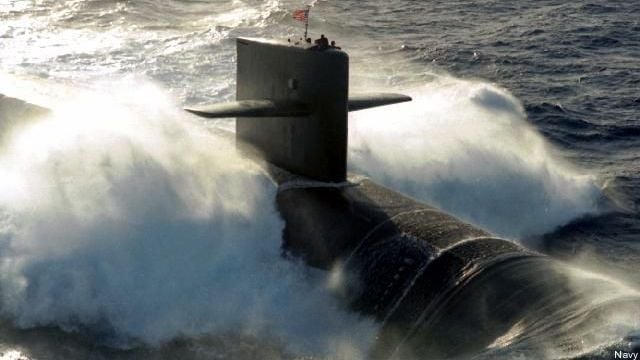Navy Sticks By Ohio Replacement Costs; CBO Says It’s 17% Higher
Posted on

An Ohio-class ballistic missile submarine.
WASHINGTON: The Navy rebuffed today a Congressional Budget Office estimate that the service is too optimistic about the cost of its new nuclear missile submarine. Still, whatever the final cost, it’s certain to be high — so high the Navy officially admits its own figures show the sub is unaffordable under current budget plans.
In that context, the CBO report that the subs will cost 17 percent more than the Navy expects is “an urgent reminder” that Congress must figure out how to fund the Ohio Replacement Program, said Rep. Joe Courtney. As co-chair of the Congressional Shipbuilding Caucus, a senior member of House seapower subcommittee, and representative from Connecticut, the home state of sub-builder Electric Boat, Courtney is a leading voice on undersea warfare. Arguing that replacing the aging Ohio-class ballistic missile submarine is essential to the nation’s nuclear deterrent, Courtney and House seapower subcommittee chairman Rep. Randy Forbes have pushed to fund the new sub outside the Navy budget.
“CBO’s report is an urgent reminder for Congress to address the funding challenges for both the Ohio Replacement and the overall shipbuilding program,” Courtney told Breaking Defense in a statement this afternoon. “I was proud to work on a bipartisan basis to establish the National Sea Based Deterrence Fund in this year’s NDAA, which will place this top-priority program outside the regular shipbuilding account. That is just a first step, however, and we will need to continue the discussion about how to prioritize shipbuilding within the defense budget when Congress returns next year.”
Overall, Courtney projected optimism about the program. “Navy leaders have been clear about the challenges they face on Ohio Replacement and its impact on other shipbuilding priorities, [and] the Navy has an aggressive plan to reduce costs,” Courtney told us. “Although the CBO and Navy projections differ on how much can be achieved in reducing costs…I am confident that the Navy and the submarine industrial base are equal to the challenge.”
How hard is the Navy trying to save money? It plans to not only reuse the Ohio‘s Trident D5 missiles but even salvage old launch tube doors from the Ohios as they’re retired. The service estimates it’s already found over $1.4 billion in savings since the research and development contract was signed in December 2012. Their overall model for program management is the Virginia-class attack submarine, which is well-regarded for cutting cost and construction time.
Historically, however, the costs of major weapons platforms remains stubbornly correlated with their weight and complexity. “Overall,” writes CBO, “the Navy expects a 19 percent improvement in the cost-to-weight relationship of the Ohio Replacement class compared with the first 12 of the Virginia class. CBO estimates a 4 percent improvement.” Overall, while the Navy forecasts the total cost for 12 subs as $79 billion — $6.6 billion apiece on average — CBO estimates a total cost of $92 billion — $7.7 billion each.
Why the big difference? The crucial issue may be as simple — and as mind-bogglingly complicated — as how CBO and the Navy calculate inflation. Forecasting such economic indicators over multiple decades is always difficult, more black art than hard science.
Worse, naval construction is particularly tricky because costs in the shipbuilding sector keep rising faster than inflation in the economy as a whole, a factor CBO says the Navy underestimates. The Navy responds, in essence, that trying to include all the factors CBO does involves so much guesswork that the estimate isn’t worth doing.
“The Navy recognizes that there are different methodologies to calculate and account for inflation,” Lt. Rob Myers, a Navy spokesman, told me this afternoon. “For consistency and comparative integrity, we utilize base year dollars throughout our 30-year shipbuilding plan. The base year dollars have been calculated using a weighted average of shipbuilding cost, thereby taking into account the higher inflation in ship building. We realize that a ship purchased today will not cost the same 20-30 years down the road, but since we cannot predict inflation ([in] GDP [generally] or ship building [specifically],) we feel that this is the best way to present information.”
Despite its differences with CBO, the Navy agrees it needs help paying for the Ohio Replacement Program. “The Chief of Naval Operations has testified and has clearly stated a number of times that additional funding for the ORP is critical,” said the CNO’s spokesman, Capt. Danny Hernandez. “Same remains true today. Without additional funding this would break our ship building account and then some.”
“‘Who pays’ is our biggest budget issue,” Hernandez told me, “and leadership is working with DoD and Congress to ensure we start construction in 2021.”
With just six years to go, that start date falls within the projected defense spending cuts known as sequestration, which are all too likely to return in 2016 and last for most of a decade. “Above all,” said Courtney, “the most urgent looming threat to fully meeting our shipbuilding needs is sequestration. The new Congress must take bipartisan action to undo these mindless cuts and prevent long term damage to our fleet and industrial base.”
Subscribe to our newsletter
Promotions, new products and sales. Directly to your inbox.
